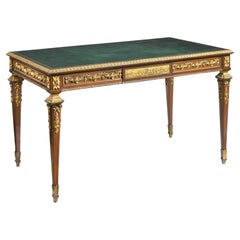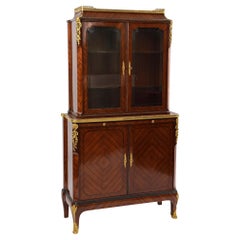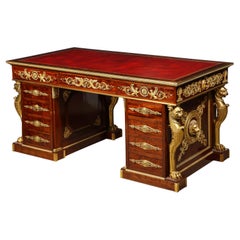Alexandre Chevrié, Paris Furniture
3
to
2
1
3
3
3
1
3
3
2
2
2
2
2
2
2
5,282
4,012
2,457
2,235
Creator: Alexandre Chevrié, Paris
A Fine Quality Louis XVI style Ormolu Mounted Mahogany Bureau Plat by Alexandre
By Alexandre Chevrié, Paris 1
Located in New York, NY
Contains gilt ornaments and a frieze of putti in heaven on either side. Topped with blind-tooled leather, an inset writing surface. Contains one large drawer that runs the width of ...
Category
Mid-19th Century Rococo Revival Antique Alexandre Chevrié, Paris Furniture
Materials
Bronze, Gold Leaf
Library /Secretary in Marquetry by Chevrie
By Alexandre Chevrié, Paris 1
Located in Los Angeles, CA
Superb furniture in marquetry and bronze in the louis XV louis XVI transition style
executed by A.Chevrie famous parisian cabinetmaker of this time.
The furniture at the top opens ...
Category
1890s French Louis XV Antique Alexandre Chevrié, Paris Furniture
Materials
Bronze
Alexandre Chevrie, Museum French Ormolu Mounted Mahogany Royal Executive Desk
By Alexandre Chevrié, Paris 1
Located in New York, NY
Alexandre Chevrie, a museum quality French ormolu mounted mahogany Royal Executive "Empire" Desk, circa 1875.
Double sided desk with six solid bronze lions paw feet, framed ormolu lions on both sized, jewel quality ormolu medusa heads concealing the drawer locks, and exquisite ormolu frieze designs throughout. With original red leather top.
Truly the best quality desk with the most sophisticated design for this Napoleon III period.
There was a similar bedroom set in this style that was made for King...
Category
19th Century French Napoleon III Antique Alexandre Chevrié, Paris Furniture
Materials
Ormolu
Related Items
Dakota Jackson French Art Deco Postmodern Mahogany Executive Partners Desk 96"
By Dakota Jackson
Located in Dayton, OH
Vintage Dakota Jackson post modern Art Deco style executive partners desk featuring mahogany with leather insert and stainless steel frame. A V-Shape pattern veneer top with Black Leather inset. 2 pedestal cabinets below: each with 2 standard drawers and 1 file drawer, front and back. Polished Stainless Steel drawer pulls, post, floor plates, and arced trestle supporting desktop. DJ Chelsea Black Leather, Polished Polyresin finish.
Dakota Jackson (born August 24, 1949) is an American furniture designer known for his eponymous furniture brand, Dakota Jackson, Inc.,[1] his early avant-garde works involving moving parts or hidden compartments,[2][3] and his collaborations with the Steinway & Sons piano company.[1]
Jackson helped establish the art furniture movement in 1970s SoHo,[4][5] later becoming a celebrity designer in the 1980s.[6][7][8] His background in the world of stage magic helped him get his first commissions and is often cited as the source of his point-of-view.[6][9]
Early life
Dakota Jackson was born on August 24, 1949, and grew up in the Rego Park neighborhood of Queens, New York.
Stage Magic
Jackson's father, Jack Malon, was a professional magician.[10] Mr. Malon learned the trade from his own father, who studied stage magic in early 20th century Poland.[1]
Jackson began studying magic at a young age and sometimes performed with his father.[11] Jackson's name, in fact, grew out of a road trip to Fargo, North Dakota.[11]
Throughout his adolescence and into his early 20s, Jackson immersed himself in the world of magic.[2] In 1963, Jackson began to perform in talent shows at his junior high school, William Cowper JHS 73 (which is known today as The Frank Sansivieri Intermediate School),[12] and at children's birthday parties.[13] Jackson also began to build his own props, including large boxes for sawing a woman in half and small boxes from which doves would emerge in full flight.[11] Jackson acknowledges the importance of these early experiences with magic to his later career as a furniture designer: "The demands of performance taught me how to discipline myself to achieve aesthetic ends."[1][2][14]
After Jackson graduated from Forest Hills High School in 1967, he continued performing as a magician, working in art galleries, night clubs, touring in the Catskills, and giving private performances at society events.[2][13][15] When he was 17, Jackson had studied with magician Jack London to learn the dangerous bullet catch trick.[16]
"What appealed to me was the notion of doing things that appeared miraculous" Jackson once recalled.[6] "I was interested in spiritualism. I was interested in things like bullet catching, things that really challenged individual sensibilities, that were frightening, on the edge."[2]
He didn't find the opportunity to perform the trick publicly until a decade later at Jackson's final professional performance as a magician.[1] It was documented in Andy Warhol's Interview (magazine), in a story titled "Dakota Jackson bites the bullet."[1][16]
Jackson admits that he sometimes tires of references to his magician background, although he acknowledges it as an important part of his history.[2]
The Downtown Arts Scene
In the late 1960s, Jackson moved into a loft on 28th Street in Chelsea.[1][17] Jackson became part of the Downtown scene, a community of "artists, dancers, performers, and musicians" who moved to the neighborhood for the cheap rent and social life.[1][8][17][18]
In October 1970, Jackson performed with the Japanese group Tokyo Kid Brothers at New York's La MaMa Experimental Theatre Club (also known as Café La MaMa) in a rock musical production called "Coney Island Play" ("Konī airando purē).[19] The show explored themes of cross-cultural communication and understanding[19] and was a follow up to the group's debut performance of "The Golden Bat" at La MaMa earlier that summer.[20][21][22] Jackson played the part of a "clever conjurer."[19]
Over the next few years, Jackson became interested in minimalist dance and performed in the dance companies of Laura Dean and Trisha Brown.[2][15][23]
Jackson credits his exposure to minimalism and minimalist dance in particular as having had a strong influence on his approach to design; in 1989, Jackson told the Los Angeles Times:
For me the essential fineness of a design is in the idea, not the object itself ... In minimalism, the object is pared down to its basic meaning by stripping away all the excrescence ... —those elements that do not contribute to the pure idea.[24]
Design career
In the early 1970s, as he experimented with performance and dance, Jackson began branching out as a special effects consultant to other magicians, film producers, and musicians[2][23] such as Donna Summer.[6][9]
The loft also gave Jackson an opportunity to apply his creativity and building skills: "These were times when lofts were not ... luxury condominiums. These were tough, tough raw spaces ... and we artists, bohemians, creative people, we created our environment. So I had to build".[17][25]
Recognizing his skills as a builder, Jackson decided to shift away from performance and become a full-time maker.[1][15][17] He began making a variety of objects, including furnishings for other artists and magic boxes with hidden compartments for art collectors and galleries.[17][24] Jackson's social connections helped spread word about his work[15] and this led to his first commissions.[1]
Early Commissions
Desk for John Lennon by Dakota Jackson
In 1974, Jackson's career as a designer began when Yoko Ono asked him to build a desk with hidden compartments for husband John Lennon.[26] "She wanted to make a piece of furniture that would be a mystical object; that would be like a Chinese puzzle," Jackson recalled in a 1986 interview published in the Chicago Tribune.[6] The result was a small cubed-shaped writing table with rounded corners reminiscent of Art Deco era style.[15] Touching secret pressure points opened the desk's compartments.[23] This commission helped build Jackson's reputation and allowed him to merge his experience as a magician and performer with his developing interest in furniture.[27]
In 1978, a bed designed for fashion designer Diane von Furstenberg garnered Jackson even more notoriety.[8][10][28] [29] Called "The Eclipse", the bed was described in The New Yorker as "large, astounding, sumptuous, with sunbursts of cherry wood and quilted ivory satin at head and foot."[10] A lighting system positioned behind the headboard switched on automatically at sunset and spread out rays of light "like an aurora borealis,"[2][17] which grew brighter and brighter until turning off at 2 am.[23][30]
Commissions like these continued to come in[8] and Jackson soon became known as a designer to the rich and famous.[30] Some of his other clients from this period included songwriter Peter Allen, Saturday Night Live creator and producer Lorne Michaels, Rolling Stone publisher Jann Wenner, and soap opera actress Christine Jones.[8]
The American Art Furniture Movement and the Industrial Style
In the late 1970s, Jackson was among a small group of artists and artisans producing and exhibiting hand-made furniture in New York.[5][31] Jackson and his peers were part of the "American Art Furniture Movement," a group sometimes called the "Art et Industrie Movement,"[32] named after the leading art furniture gallery of the era,[32] Art et Industrie, founded by Rick Kaufmann in 1976.[33]
In a 1984 Town & Country article titled "Art You Can Sit On," Kaufmann said he created the gallery to "serve as a locus to the public for artists and designers creating new decorative arts."[31] The works on display were "radical objects" that drew from a number of fine art traditions, including "Pop, Surrealism, Pointillism and Dada [which were] "thrown together with the severe lines of the Bauhaus and the Russian avant-garde, mixed with Mondrian's color and filtered through a video sensibility—all to create a new statement."[31] The article described Jackson as a "ten-year veteran of the genre" and pointed to the "clean forms and quiet colors" of his furniture.[4]
Jackson showed a variety of industrial-looking lacquer, metal, and glass works at Art et Industrie, including his Standing Bar (also known as the Modern Bar),[33] a lacquered cabinet that Jackson designed in 1978 for his wife (then-girlfriend) RoseLee Goldberg.[13]
Other works from this period include the T-Bird Desk, Self-Winding Cocktail Table, and the Saturn Stool...
Category
Late 20th Century Art Deco Alexandre Chevrié, Paris Furniture
Materials
Stainless Steel
H 30 in W 96 in D 42 in
Chippendale Secretary/Desk
By Thomas Chippendale
Located in New Haven, CT
George III period mahogany Chinese Chippendale secretary bookcase, England, circa 1790. The original ogee bracket feet and the broken arc...
Category
1790s English Chippendale Antique Alexandre Chevrié, Paris Furniture
Materials
Mahogany
Louis XV Style Bureau Plat
Located in Palm Beach, FL
Attractive Louis XV style bureau plat, gilt embossed tanned leather top writing surface centered on a beautiful satinwood veneered panel and...
Category
Late 20th Century French Louis XV Alexandre Chevrié, Paris Furniture
Materials
Wood
Louis XVI Tulipwood and Ormolu Mounted Bureau Plat
Located in Essex, MA
A signed piece with rectangular top with inset green leather, possibly original , over a frieze with one central drawer flanked by drawers each with round original wreath rings...
Category
1780s French Louis XVI Antique Alexandre Chevrié, Paris Furniture
Materials
Bronze
Baker Mahogany Executive Partners Desk, Georgian, Writing Table
By Baker Furniture Company
Located in Stamford, CT
Large mahogany executive partners desk by baker, writing table in the Georgian Fashion.
A stunning new Baker mahogany partners desk having fu...
Category
2010s American Georgian Alexandre Chevrié, Paris Furniture
Materials
Mahogany
Executive Desk, Corner Desk in Mahogany, Germany, 1970's
By Johannes Andersen, Arne Vodder
Located in Wiesbaden, DE
Beautifully designed writing desk in teak. With a very distinct design this desks every wood surface has been given specific angles such as the tabletop, the unit with drawers as wel...
Category
Mid-20th Century German Scandinavian Modern Alexandre Chevrié, Paris Furniture
Materials
Metal
Danish Teak Bookcase, Desk Secretary by Poul Hundevad
Located in Pomona, CA
This gorgeous secretary was designed by one of the premier Danish Mid-Century designers, Poul Hundevad. As many of the mid-century designers were, Hundevad was inspired by the past f...
Category
Late 20th Century Danish Alexandre Chevrié, Paris Furniture
Materials
Teak
Fine French Ormolu Mounted Mahogany Directoire Marble Top Mirrored Vanity Desk
Located in Swedesboro, NJ
This is a superbly crafted antique French Directoire style brass inlaid and bronze mounted secretaire desk or ladies vanity. The piece is perfect for paying bills or using as a makeup vanity...
Category
1890s French Directoire Antique Alexandre Chevrié, Paris Furniture
Materials
Marble, Brass, Bronze
H 48.75 in W 31.5 in D 18 in
1968 Executive Desk
By Warren Platner
Located in Hanover, MA
Executive desk formerly belonging to noted architect George M. Notter, (1933–2007) of the Boston firm Anderson Notter Finegold (now known as Finegold Alexander Architects).
Current institutional memory at the firm suggests it was a special order from Herman Miller for the then new New York offices of MGM, however Herman Miller's archivist was unable to confirm.
Styling, particularly the distinctive slim milled aluminum tracks through which the entire drawer carriage glides is clearly similar to Warren Platner's designs for Lehigh-Leopold which were then among the most costly of executive office furnishings. The bent flat bar chromed steel base with its distinctive pigeon toe splay is somewhat similar to a table base in Stow Davis' Electa Series, designed by Alexis Yermakov circa 1971. Walnut laminate top is very clean with no issues. One one corner edge shows a small separation.
The only identifying markings are within the milled aluminum channel:
G.P.
F.I.
2
And the date Dec. 20, 1968.
See image 18.
Between the rectangular laminate top and the chrome base is a heavy blackened steel plate. Underneath the bent chrome pigeon toe feet are bars of a thick phenolic material which act as floor protector.
We can have keys made to fit the two locking drawers.
Tim Anderson...
Category
1960s American Mid-Century Modern Vintage Alexandre Chevrié, Paris Furniture
Materials
Aluminum, Steel, Chrome
Secretary by Gianfranco Frattini for Bernini, 1960s
By Gianfranco Frattini, Bernini
Located in Lasne, BE
Wooden secretary. The roll top opens by pulling on the leather inlaid writing surface, underneath it are small drawers. This secretary has 10 drawers in the front, several drawers behind the roll top and in the back there are two glass shelves. The legs are made of solid wood and are connected by aluminum strips. On the top there is a glass shelf on which you can put objects while using the rolling...
Category
1960s Italian Mid-Century Modern Vintage Alexandre Chevrié, Paris Furniture
Materials
Aluminum
French Empire Style Mahogany Bureau Plat
Located in Winter Park, FL
An early 20th century French Empire style bureau plat, or executive desk, with five dovetailed drawers and pull-out side extensions. Bookmatched flame mahogany veneer over solid oak....
Category
Mid-20th Century French Empire Alexandre Chevrié, Paris Furniture
Materials
Brass
Antique French Ormolu Mounted Escritoire Writing Desk
Located in London, GB
A stunning antique French writing table, also known as an escritoire. This dates from around the 1930’s.
It is has a very beautiful and useful design, with a very elegant form. Ther...
Category
1930s French Louis XV Vintage Alexandre Chevrié, Paris Furniture
Materials
Ormolu
Alexandre Chevrié, Paris furniture for sale on 1stDibs.
Alexandre Chevrié, Paris furniture are available for sale on 1stDibs. These distinctive items are frequently made of metal and are designed with extraordinary care. There are many options to choose from in our collection of Alexandre Chevrié, Paris furniture, although brown editions of this piece are particularly popular. Many of the original furniture by Alexandre Chevrié, Paris were created in the louis xv style in france during the 19th century. If you’re looking for additional options, many customers also consider furniture by Victor Raulin, François Linke, and Alfred Emmanuel Louis Beurdeley. Prices for Alexandre Chevrié, Paris furniture can differ depending upon size, time period and other attributes — on 1stDibs, these items begin at $6,200 and can go as high as $395,000, while a piece like these, on average, fetch $25,500.




